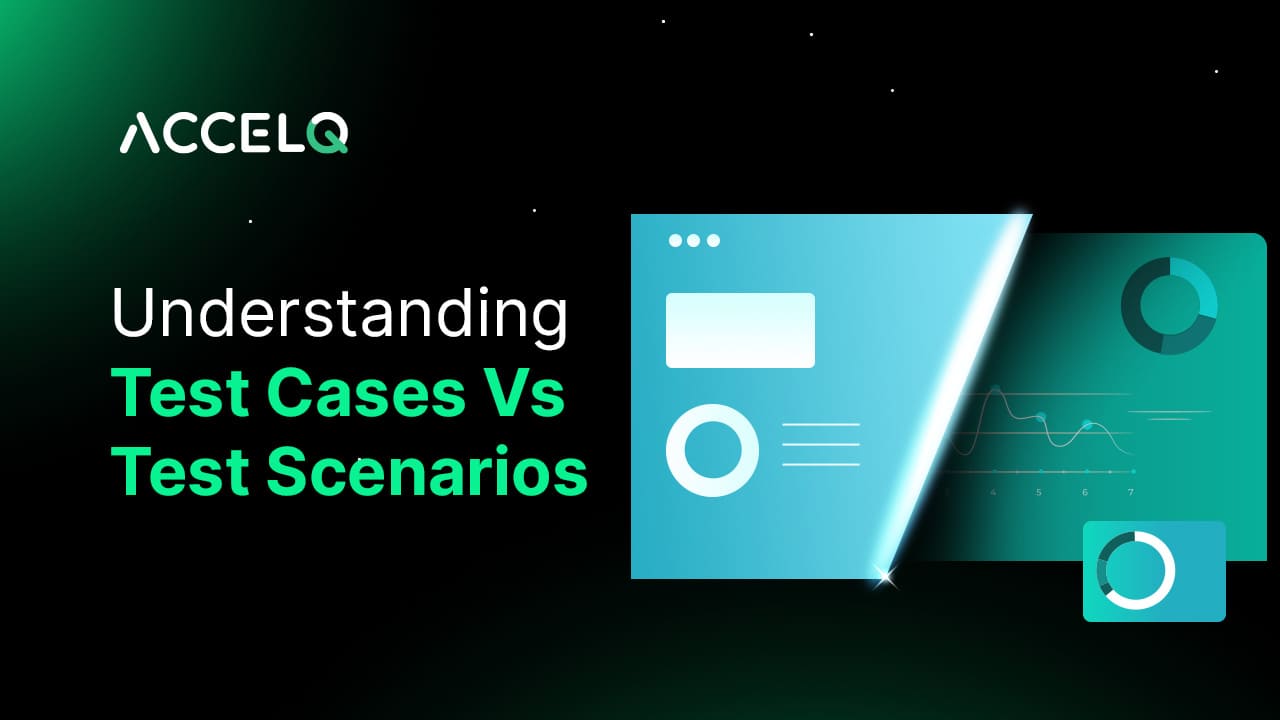Test Case vs Test Scenario: Know the Key Differences

In software testing, the differences between “test case” and “test scenario” are subtle, yet important. “Testing Strategy” must be developed to know the ways in which these two test artifacts are different & how they influence each other in your QA lifecycle.
In this complete guide, we’ll be covering the meaning, examples, use cases, and strategic solutions in the realm of both test cases and test scenarios, and show how modern QA teams can minimize effort on both, enabled by AI-powered automation platforms.
- What is a Test Scenario?
- What is a Test Case?
- Test Case vs Test Scenario: A Quick Comparison
- Use Case vs Test Scenario vs Test Case
- Strategic Timing in SDLC
- Writing Effective Test Scenarios and Test Cases
- Real-World Example
- Scenario Variants and Extensions
- Understanding Related Testing Terms
- The Role of AI in Managing Test Cases and Scenarios
- Common Misconceptions
- Conclusion
What is a Test Scenario?
A test scenario is a high-level concept of what you want to test. It gives an overview of the system functionality in general at the user level. Based on use cases, use case-based test scenario templates, and requirement documents, TWSC test scenarios were efficient for achieving full coverage of the test and business coverage.
Key Characteristics:
- Abstract and high-level
- Represents a functionality or user story
- Useful for identifying test coverage
- Ideal for exploratory and requirement-based testing
Example:
Test Scenario: Verify login functionality for a registered user.
This test scenario would then be broken into multiple test cases addressing valid and invalid inputs, different browsers, or edge conditions.
What is a Test Case?
A test case is a detailed, documented set of instructions used to validate a particular feature or function of the application. It includes inputs, execution steps, expected outcomes, and post-conditions. Test cases are concrete and directly executable, often forming the basis of automated testing scripts.
If you’re wondering what is a test case in testing is, here’s a solid reference on how to write test cases. It’s essentially the backbone of structured QA, offering a methodical way to verify requirements.
Key Characteristics:
- Granular and specific
- Contains step-by-step instructions
- Includes expected results
- Suitable for both manual and automated testing
Example:
Test Case: Verify login with valid credentials.
- Navigate to login page
- Enter valid username
- Enter valid password
- Click login
- Verify successful redirection to user dashboard
Test Case vs Test Scenario: A Quick Comparison
| Feature | Test Scenario | Test Case |
|---|---|---|
| Definition | High-level functionality to be tested | Specific steps to verify a function |
| Detail Level | Abstract | Detailed |
| Purpose | Understand what to test | Define how to test |
| Input & Output | Not defined | Clearly defined |
| Reusability | High | Medium |
| Automation Friendly | Indirectly | Yes |
| Traceability | Linked to use cases or user stories | Linked to scenarios and requirements |
This table clarifies scenario vs test case and helps teams understand how these artifacts relate.
Use Case vs Test Scenario vs Test Case
It’s important to understand the flow between use cases, test scenarios, and test cases:
- Use Case: A specific interaction between a user and the system (e.g., “User logs in to the system”)
- Test Scenario: Broad functionality to test (e.g., “Verify login functionality”)
- Test Case: Actionable validation (e.g., “Login with valid credentials”)
Strategic Timing in SDLC
Both test scenarios and test cases should be designed early in the Software Development Life Cycle (SDLC):
- Test Scenarios: Created during the requirement gathering or sprint planning stage to ensure comprehensive coverage.
- Test Cases: Created after scenarios, with detailed steps for execution during QA phases.
Writing both early improves test traceability, aligns QA with business needs, and reduces defects in later stages.
Writing Effective Test Scenarios and Test Cases
Tips for Writing Test Scenarios:
- Use clear and concise language
- Base them on functional and business requirements
- Ensure each scenario maps to a use case
- Cover both positive and negative flows
Tips for Writing Test Cases:
- Include all possible inputs and conditions
- Define expected results
- Ensure reusability where possible
- Maintain modularity to reduce maintenance effort
For deeper insights, explore test case design techniques that enhance structure and clarity.
Real-World Example
Scenario: Verify shopping cart functionality on an e-commerce site
Test Cases:
- Add a single item to cart
- Remove item from cart
- Update item quantity
- Verify price calculations
- Proceed to checkout with an empty cart
This example demonstrates a test scenario in software testing where multiple test cases branch from a single scenario.
Scenario Variants and Extensions
To better understand a test scenario in software testing with an example, consider the following:
Scenario: Validate password reset feature
- Test case 1: Request reset with registered email
- Test case 2: Request reset with unregistered email
- Test case 3: Follow reset link after expiration
For clarity, teams often maintain a test case vs test scenario with an example list to distinguish implementation steps from high-level goals.
Understanding Related Testing Terms
A test scenario template helps QA teams maintain consistency and traceability by defining fields like scenario ID, objective, related test cases, and business requirement references.
Automation scenarios refer to workflows or functional areas identified for automated testing—crucial in fast-paced CI/CD environments where regression tests need to be repeated frequently.
The Role of AI in Managing Test Cases and Scenarios
As development cycles shrink and product complexity grows, managing large volumes of test artifacts manually becomes a bottleneck. This is where AI-powered, no-code testing platforms can offer a significant edge.
Benefits of AI-Powered Test Management:
- Auto-generates test cases from user stories and requirements
- Uses NLP to convert plain English to test logic
- Offers visual scenario designers for easy mapping
- Provides analytics-driven insights and traceability
- Enables reusability and modular test architecture
Tools like ACCELQ allow teams to maintain velocity while ensuring comprehensive and reusable test coverage. Learn how AI in test case management helps scale and simplify the QA process.
Common Misconceptions
- Test Scenarios are optional: Not true. Scenarios help QA teams validate whether their test plan covers all required functionality.
- Test Cases are always manual: Many modern tools support automated test case execution, especially with reusable steps.
- You only need one or the other: Scenarios and test cases complement each other and are both essential for robust QA.
Conclusion
In the fast-moving world in which we live, being able to differentiate between test scenarios and test cases is not only best practice but a necessity. If test scenarios are sketched out, authors at azure.com must test from top to bottom, and then test cases take that into the execution territory.
Use Case vs Test Scenario: Exploring test scenarios and mapping automation paths, it’s important to know the differences and look for QA strategies that are aligned, scalable, and future-proof.
Through a combination of strategically using and implementing AI-based, codeless automation solutions, QA teams can significantly increase test coverage, shorten cycles, and improve software quality. The secret isn’t to pick one or the other—but how to learn to leverage both together to deliver useful, user-centered digital experiences.
Prashanth Punnam
Sr. Technical Content Writer
With over 8 years of experience transforming complex technical concepts into engaging and accessible content. Skilled in creating high-impact articles, user manuals, whitepapers, and case studies, he builds brand authority and captivates diverse audiences while ensuring technical accuracy and clarity.
You Might Also Like:
 Behavior-driven Development (BDD) Testing: A Complete Tester’s Guide
Behavior-driven Development (BDD) Testing: A Complete Tester’s Guide
Behavior-driven Development (BDD) Testing: A Complete Tester’s Guide
 What is Exploratory Testing, and what is its role in Agile practices?
What is Exploratory Testing, and what is its role in Agile practices?
What is Exploratory Testing, and what is its role in Agile practices?
 What is Unit Testing? Best Practices to Do it Right
What is Unit Testing? Best Practices to Do it Right

































